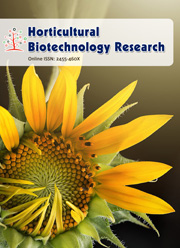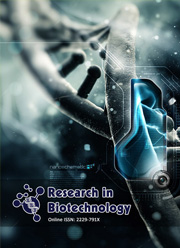Propagation of Coccinia cordifolia (L.) Cogn. from shoot tip and nodal segment through micropropagation techniques
DOI:
https://doi.org/10.25081/hbr.2021.v7.7285Keywords:
Cocconia cordifolia, micropropagation, axillary shoots, plant growth regulators, shoot regenerationAbstract
The present work was undertaken to develop a reproducible protocol for the micropropagation of an important medicinal plant of the Cucurbitaceae family, Coccinia cordifolia (L.) Cogn., by using shoot tips and nodal segments to overcome the impediment in seed settings and seed germination of conventional reproduction. To develop an efficient protocol, 0.1% HgCl2 treatment for 6 minutes was found effective for surface sterilization of field-grown explants to eliminate microbes and fungus and to get healthy tissues. Throughout the study, different concentrations of auxin, cytokine, and gibberellin were used either alone or in combination as supplemented in MS medium to find suitable conditions and suitable explant (nodal segment). BAP was the best cytokine source as 2.0 mg/l BAP produced 4.0±0.20 and 4.8±0.09 shoots per culture and gained 5.8±0.11 cm and 6.7±0.32 cm length with regeneration rate of 90 and 100 percent in shoot tips and node, respectively. The highest percentage (90%) of regeneration for axillary shoot proliferation was obtained in node explants at MS medium containing 2.0 mg/l BAP + 0.1 mg/l NAA. The highest number of shoots regenerated per culture was 3.0±0.41, with a length of 6.0±0.16 cm. GA3 was also found effective in producing longer shoots with the combination of BAP, but the average shoot number was reduced drastically. Although full-strength MS medium was found to be ideal for shoot regeneration and used in shoots proliferated experiments, half and full-strength of MS medium with auxins supplements of 0.5, 1.0, and 2.0 mg/l either of IBA, NAA, and IAA) were used for roots growth and half strength nutrients supplemented with 0.5 mg/l IBA was found most compelling. The highest number of roots regenerated per shoot was 3.1±0.30, and the average root length was 1.8±0.30 cm. Rooted plantlets were finally transplanted into small plastic pots containing sun sterilized sand, soil and humus (1: 2: 1) to adapt the plantlet in ex vitro environment, and acclimatized plantlets showed 95% survival rate in outdoor condition which proved the effectiveness of using biotechnology to improve plant’s growth rate and mass production.
Downloads
References
Alam, I., Sharmin, S. A., Naher, M. K., Alam, M. J., Anisuzzaman, M., & Alam, M. F. (2013). Elimination and detection of viruses in meristem-derived plantlets of sweetpotato as a low-cost option toward commercialization. 3 Biotech, 3(2), 153–164. https://doi.org/10.1007/s13205-012-0080-6
Alam, J., Alam, I., Sharmin, S. A., Rahman, M., Anisuzzaman, M., & Alam, M. F. (2010). Micropropagation and antimicrobial activity of Operculina turpethum (Syn. 'Ipomoea turpethum'), an endangered medicinal Plant. Plant Omics, 3(2), 40-46.
Alam, M. F., Banu, M. L. A., Swaraz, A. M., Parvez, S., Hossain, M., Khalekuzzaman, M., & Ahsan, N. (2004). Production of virus free seeds using meristem culture in tomato plant under tropical conditions. Journal of Plant Biotechnology, 6(4), 221-227.
Alam, M. F., Mondol, P. C., Roy, S. K., Anisuzzaman, M., Parvez, M. S., Ray, S. K., Mahzabin, F., Tanny, T., & Alam, I. (2019). Determination of Apposite plant regeneration protocol for several cucurbits through direct and indirect organogenesis. Horticulture Biotechnology Research, 5, 4-13. https://doi.org/10.25081/hbr.2019.v5.5279
Amin, M. N., Azad, M. A. K., & Begum, F. (1997). In vitro plant regeneration from leaf-derived callus cultures of Adhatoda vasica Nees. Plant Tissue Culture, 7(2), 109-115.
Anand, S. P., & Jeyachandran, R. (2004). In vitro multiple shoot regeneration from nodal explants of Zehneria scabra (Lf) Sonder - An important medicinal climber. Plant Tissue Culture, 14(2), 101-106.
Anand, S. P., Jeyachandran, R., & Xavier, T. F. (2003). Antibacterial activities of Zehneria scabra root extracts. Journal of Tropical Medicinal Plants, 4(2), 173-180.
Anisuzzaman, M., Sharmin, S. A., Mondal, S. C., Sultana, R., Khalekuzzaman, M., Alam, I., & Alam, M. F. (2008). In vitro microrhizome induction in Curcuma zedoaria (Christm.) Roscoe - A conservation prioritized medicinal Plant. Journal of Biological Sciences, 8(7), 1216-1220. https://doi.org/10.3923/jbs.2008.1216.1220
Ara, M., Jahan, A., & Hadiuzzaman, S. (1993, December 19-21). In vitro plant regeneration from leaf explant of Solanum sisymbrifolium Lamk in Bangladesh. International Plant Tissue Culture Conference, Dhaka.
Barna, K. S., & Wakhlu, A. K. (1988). Axillary shoot induction and plant regeneration in Plantago ovata Forssk. Plant Cell, Tissue and Organ Culture, 15(2), 169-173. https://doi.org/10.1007/BF00035758
Begum, F., Amin, M. N., Islam, S., Azad, M. A. K., & Rehman, M. M. (2003). In Vitro Plant Regeneration from Cotyledon-Derived Callus of Three Varieties Pummelo (Citrus Grandis (L.) Osb.). Journal of Biological Science, 3(8), 751-759.
Bhattacharya, B., Lalee, A., Mal, D. K., & Samanta, A. (2011). In-vivo and in-vitro anticancer activity of Coccinia grandis (L.) Voigt. (Family: Cucurbitaceae) on Swiss albino mice. Journal of Pharmacy Research, 4(3), 567-569.
Bhattacharya, B., Samanta, M., Pal, P., Chakraborty, S., & Samanta, A. (2010). In vitro evaluation of antifungal and antibacterial activities of the plant Coccinia grandis (L.) voigt (Family-Cucurbitaceae). Journal of Phytology, 2(11), 52-57.
Bhojwani, S. S., & Razdan, M. K. (1986). Plant Tissue Culture: Theory and Practice (Developments in Crop Science). Amsterdam: Elsevier.
Borah, A. R., Anbumalarmathi, J., & Sharmili, S. A. (2019). In vitro propagation of Coccinia indica (L.) Voigt. from internodal segments. Indian Journal of Agricultural Research, 53(2), 202-207.
Britto, J. O. H. N., Robinson, S. J. J., Natarajan, E., & Arockiasamy, D. I. (2001). Micropropagation of Hyptis suaveolens [L.] Poit.[Labiatae] Through Nodal Culture. Advances in Plant Sciences, 14(2), 561-566.
Datta, K., & Datta, S. K. (1984). Auxin induced clonal multiplication of Holarrhena antidysenterica by tissue culture. Journal of Tree Sciences, 3(1-2), 45-52.
Deshpande, S. V., Patil, M. J., Daswadkar, S. C., Suralkar, U., & Agarwal, A. (2011). A study on anti-inflammatory activity of the leaf and stem extracts of Coccinia grandis L. voigt. International Journal of Applied Biology and Pharmaceutical Technology, 2(3), 247-250.
Devendra, N. K., Rajanna, L., Sheetal, C., & Seetharam, Y. N. (2009). In vitro Clonal Propagtion of Trichosanthes cucumerina L. var. cucumerina. Plant Tissue Culture and Biotechnology, 18(2), 103–111. https://doi.org/10.3329/ptcb.v18i2.3270
Girish, C., Balakrishnan, S., Koner, B. C., Jayanthi, S., Rao, K. R., Rajesh, B., & Pradhan, S. C. (2011). Evaluation of antiulcer activity of Coccinia grandis leaves. Research Journal of Pharmacology and Pharmacodynamics, 3(2), 92-95.
Hussain, A., Wahab, S., Rizvi, A., & Hussain, M. (2011). Macroscopical, anatomical and physio-chemical studies on leaves of Coccinia indica Wight & Arn., growing wildly in eastern Uttar Pradesh region of India. Indian Journal of Natural Products and Resources, 2(1), 74-80.
Jamwal, A., & Kumar, S. (2019). Antidiabetic activity of isolated compound from Coccinia indica. Indian Journal of Pharmaceutical Education and Research, 53(1), 151-159.
Karim, M. A., & Ahmed, S. U. (2010). Somatic embryogenesis and micropropagation in teasle gourd. International Journal of Environmental Science and Development, 1(1), 10-14.
Kashem, M. A., & Rahman, M. M. (2018). Micropropagation of Coccinia grandis (Linn.) Voigt. Through organogenesis. European Journal of Biotechnology and Bioscience, 6(6), 63-68.
Khalekuzzaman, M., Khatun, M., Rashid, M. H., Sheikh, M. I., Sharmin, S. A., & Alam, I. (2012). Micropropagation of an elite F1 watermelon (Citrullus lanatus) hybrid from the shoot tip of field grown plants. Brazilian Archives of Biology and Technology, 55(3), 335-340. https://doi.org/10.1590/S1516-89132012000300002
Kuriyan, R., Rajendran, R., Bantwal, G., & Kurpad, A. V. (2008). Effect of supplementation of Coccinia cordifolia extract on newly detected diabetic patients. Diabetes care, 31(2), 216-220. https://doi.org/10.2337/dc07-1591
Murashige, T. & Skoog, F. (1962). A revised medium for rapid growth and bioassays with tobacco tissue cultures. Physiologia Plantarum, 15, 473–497. https://doi.org/10.1111/j.1399-3054.1962.tb08052.x
Nachimuthu, S. Suresh, K., Sadhasivam B., Veerichetty V., & Ponnusamy R. (2018). Development and evaluation of anti inflammatory ointment using aqueous extract of Coccinia grandis L. International Journal of Green Pharmacy, 12(3), S589-S596.
Nataraja, K., & Ganapathi, T. R. (1989). In vitro plantlet regeneration from cotyledons of Helianthus annuus cv. Morden (sunflower). Indian Journal of Experimental Biology, 27(9), 777-779.
Pal, S. P., Alam, I., Anisuzzaman, M., Sarker, K. K., Sharmin, S. A., & ALAM, M. F. (2007). Indirect organogenesis in summer squash (Cucurbita pepo L.). Turkish Journal of Agriculture and Forestry, 31(1), 63-70.
Patel, A. R., & Ishnava, K. B. (2015). In vitro shoot multiplication from nodal explants of Coccinia grandis (L.) Voigt. and it’s antidiabetic and antioxidant activity. Asian Journal of Biological Sciences, 8(2), 57-71. https://doi.org/10.13140/RG.2.1.2917.9603
Pekamwar, S. S., Kalyankar, T. M., & Kokate, S. S. (2013). Pharmacological activities of Coccinia grandis. Journal of Applied Pharmaceutical Science, 3(5), 114-119. https://doi.org/10.7324/JAPS.2013.3522
Pierik, R. L. M. (1997). In vitro culture of higher plants. Dordrecht: Springer science & business media. https://doi.org/10.1007/978-94-011-5750-6
Ravikumar, S., Inbaneson, S. J., & Suganthi, P. (2012). In vitro antiplasmodial activity of ethanolic extracts of South Indian medicinal plants against Plasmodium falciparum. Asian Pacific Journal of Tropical Disease, 2(3), 180-183. https://doi.org/10.1007/s00436-010-2128-z
Roy, G. K., & Khan, S. A. (2020). Preliminary taxonomic study on homestead flora of four districts of Bangladesh: Magnoliopsida. Bangladesh Journal of Plant Taxonomy, 27(1), 37-65. https://doi.org/10.3329/bjpt.v27i1.47567
Sarker, P. F. M. S., Jahan, R., & Rahmatullah, M. (2009). In vitro regeneration of Coccinia grandis (L.) Voigt., an indigenous medicinal plant of Bangladesh. African Journal of Traditional, Complementary and Alternative Medicines, 351-352.
Shakya, V. K. (2008). Antidiabetic activity of Coccinia indica in streptozotocin induced diabetic rats. Asian Journal of chemistry, 20(8), 6479-6482.
Sharmin, S. A., Alam, M. J., Sheikh, M. M. I., Zaman, R., Khalekuzzaman, M., Mondal, S. C., Haque, M. A., Alam, M. F., & Alam, I. (2013). Micropropagation and antimicrobial activity of Curcuma aromatica Salisb., a threatened aromatic medicinal plant. Turkish Journal of Biology, 37(6), 698-708. https://doi.org/10.3906/biy-1212-11
Sivaraj, A., Jenifa, B. P., Kavitha, M., Inbasekar, P., Senthilkumar, B., & Panneerselvam, A. (2011). Antibacterial activity of Coccinia grandis leaf extract on selective bacterial strains. Journal of Applied Pharmaceutical Science, 1(7), 120-123.
Sundari, U. T., Sherif, N. A., Benjamin, J. F., & Rao, M. V. (2011). Rapid micropropagation via axillary bud proliferation of Coccinia grandis (L.) Voigt. from nodal segments. Plant Tissue Culture and Biotechnology, 21(1), 75-82.
Tamilselvan, N., Thirumalai, T., Elumalai, E. K., Balaji, R., & David, E. (2011). Pharmacognosy of Coccinia grandis: a review. Asian Pacific Journal of Tropical Biomedicine, 1(2), S299-S302. https://doi.org/10.1016/S2221-1691(11)60176-7
Taur, D. J., & Patil, R. Y. (2011). Mast cell stabilizing, antianaphylactic and antihistaminic activity of Coccinia grandis fruits in asthma. Chinese Journal of Natural Medicines, 9(5), 359-362. https://doi.org/10.3724/SP.J.1009.2011.00359
Tefera, W., & Wannakrairoj, S. (2004). A micropropagation method for korarima (Aframomum corrorima (Braun) Jansen). Science Asia, 30, 1-7.
Tripathi, L., & Tripathi, J. N. (2003). Role of biotechnology in medicinal plants. Tropical Journal of Pharmaceutical Research, 2(2), 243-253.
Verma, V. M., Aikne, J., & David, J. (2004, September). Micropropagation and germplasm conservation of sweet potato (Ipomoea batatas (L.) Lam.) by tissue culture. Proceedings of the 4th International Crop Science Congress, Brisbane, Australia.
Yadav, G., Mishra, A., & Tiwari, A. (2010). Medical properties of ivy gourd (Cephalandra indica): A review. International Journal of Pharmaceutical Research and Development, 2(9), 92-98.
Zakaria, D. M., Islam, M., Anisuzzaman, S. M., Kundu, S. K., Khan, M. S., & Begum, A. A. (2011). Ethnomedicinal survey of medicinal plants used by folk medical practitioners in four different villages of Gazipur district, Bangladesh. Advance in Natural and Applied Sciences, 5(4), 392.
Published
How to Cite
Issue
Section
Copyright (c) 2022 Md. Taufiqur Rahman Sarkar, Md. Mizanur Rahman, Mohammad Firoz Alam

This work is licensed under a Creative Commons Attribution 4.0 International License.



 .
.